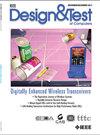A Look at Variability and Aging
引用次数: 0
Abstract
h THE NEED FOR more densely packed, faster and more energy-efficient devices has forced significant evolutions in device architectures in recent years. A challenging byproduct of such trends is increased variability of the performance parameters of manufactured devices and a move towards increased electrical stresses imposed on devices during their field use. In turn, increased electrical stress causes further increases in performance variability over time. In shorter form, two major obstacles arise for modern IC designers: variability and aging. The focus of this special issue is to bring to our attention the need for mediating impacts of variability and aging across the many stages of IC and integrated systems design. Developing innovative, yet feasible solutions for these matters are an urgent concern for future computing systems surging forward on the cusp of innovation. This month we bring you a collection of articles that thoroughly examine how the impacts of variability and aging are seen by experts and can be dealt with. To begin this special-themed issue, a paper by Bowman et al. discusses the effects of variability on microprocessor performance through an analysis of error-detection and recovery circuits, among other circuit types and monitors. An article by Wang et al. then provides a detailed look at the variability and reliability of 6T-SRAM memory systems, to show the criticality of variability effects on SRAM in computing systems. In our third article, Gupta and Roy continue the SRAM focus but specifically regard FinFET technology with a cost-benefit analysis through specific device and circuit co-designmethods. Next, Chen et al. shed light on mitigating strategies to offset NBTI effects in current circuit optimizing methods. We follow this with a paper by Stott et al. that looks at the impacts of variability and aging in FPGAs. This article proposes an adaptive system that can reconfigure its own architecture to counter variability and aging effects. A sixth entry by Debashi and Fey presents the capabilities of using Boolean Satisfiability in automating speedpath debugging under timing variations. We have also included in this final issue of 2013, three general interest articles that step away from our detailed look at variability and aging. The first of the three is an examination by Villacorta et al. of a dominant failuremechanism innanometer technology that of open defects in vias. Results of risk and reliability analyses show that new electromigration design rules are needed in light of resistive vias. The following article, provided by Laraba et al. from the TIMA Laboratory in Grenoble, demonstrates a low-cost digital monitoring alternative in reduced code testing. The last featured article is a contribution from Sayil et al. on transient noise effects caused by single event particles. The authors focus on coupling-induced soft-error mechanisms in combinational logic. We conclude this issue with ‘‘The Last Byte’’ by Scott Davidson. We hope you enjoy reading this final issue of the year, and we look forward to bringing you relevant, thought-provoking, and informative articles in 2014. Already we have an exciting slate of issues to look forward to. From all of us who contribute to producing D&T issues, I would like to wish our readers a happy holiday season and express a big ‘‘thank you!’’ to all our authors and reviewers. See you all in 2014! h变异与衰老的关系
近年来,对更密集、更快、更节能的设备的需求迫使设备架构发生了重大演变。这种趋势的一个具有挑战性的副产品是制造设备的性能参数的变异性增加,以及在现场使用过程中对设备施加的电气应力增加。反过来,随着时间的推移,增加的电应力导致性能变异性进一步增加。简而言之,现代IC设计师面临两大障碍:可变性和老化。本期特刊的重点是让我们注意到,在IC和集成系统设计的许多阶段,需要调节可变性和老化的影响。为这些问题开发创新的、可行的解决方案是未来的计算系统在创新的尖端突飞猛进的一个迫切关注的问题。本月,我们将为您带来一系列文章,深入探讨专家如何看待变异和衰老的影响,以及如何应对这些影响。为了开始这个专题问题,Bowman等人的一篇论文通过分析错误检测和恢复电路,以及其他电路类型和监视器,讨论了可变性对微处理器性能的影响。Wang等人的一篇文章随后详细介绍了6T-SRAM存储系统的可变性和可靠性,以显示可变性对计算系统中SRAM的影响的重要性。在我们的第三篇文章中,Gupta和Roy继续关注SRAM,但特别关注FinFET技术,并通过特定的器件和电路协同设计方法进行成本效益分析。接下来,Chen等人阐明了在当前电路优化方法中抵消NBTI效应的缓解策略。我们随后发表了一篇由Stott等人撰写的论文,该论文研究了fpga中可变性和老化的影响。本文提出了一种自适应系统,它可以重新配置自己的结构来对抗可变性和老化效应。Debashi和Fey的第六篇文章介绍了在时间变化下使用布尔可满足性自动化高速路径调试的能力。在2013年的最后一期中,我们还收录了三篇一般性的文章,这些文章远离了我们对可变性和衰老的详细研究。其中第一个是Villacorta等人对纳米技术中主要失效机制即通孔中开放缺陷的研究。风险和可靠性分析结果表明,针对电阻式过孔,需要制定新的电迁移设计规则。下面的文章,由格勒诺布尔TIMA实验室的Laraba等人提供,演示了在减少代码测试中的低成本数字监控替代方案。最后一篇专题文章是Sayil等人关于单事件粒子引起的瞬态噪声效应的贡献。作者着重研究了组合逻辑中耦合诱导的软误差机制。我们以斯科特·戴维森的《最后一个字节》作为这期的总结。我们希望你喜欢阅读这一年的最后一期,我们期待在2014年为你带来相关的、发人深省的、翔实的文章。我们已经有一系列令人兴奋的问题值得期待。在此,我谨代表我们所有为《科技报》撰稿的人,祝我们的读者节日快乐,并致以衷心的感谢!致我们所有的作者和审稿人。2014年再见!h
本文章由计算机程序翻译,如有差异,请以英文原文为准。
求助全文
约1分钟内获得全文
求助全文

 求助内容:
求助内容: 应助结果提醒方式:
应助结果提醒方式:


